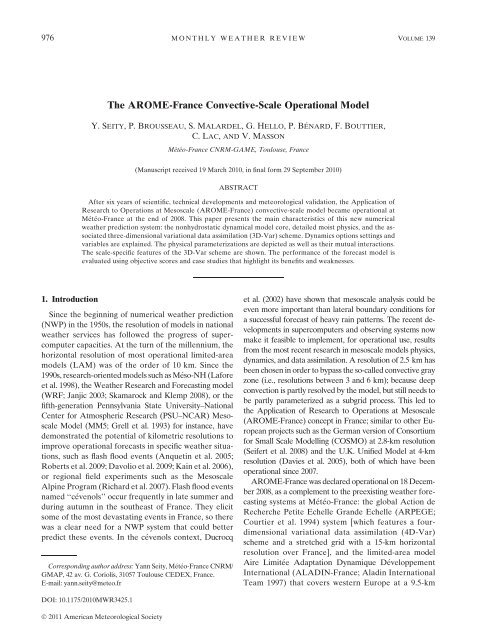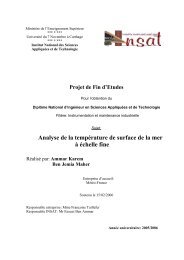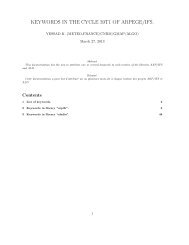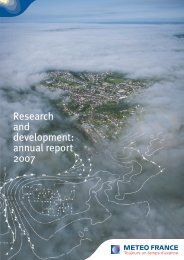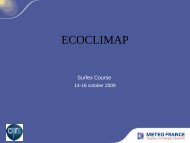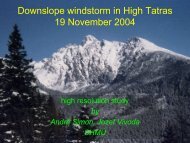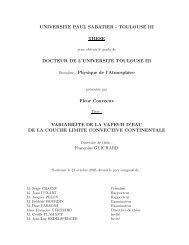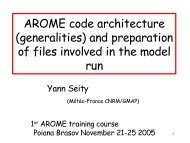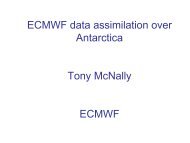The AROME-France Convective-Scale Operational Model
The AROME-France Convective-Scale Operational Model
The AROME-France Convective-Scale Operational Model
Create successful ePaper yourself
Turn your PDF publications into a flip-book with our unique Google optimized e-Paper software.
976 MONTHLY WEATHER REVIEW VOLUME 139<strong>The</strong> <strong>AROME</strong>-<strong>France</strong> <strong>Convective</strong>-<strong>Scale</strong> <strong>Operational</strong> <strong>Model</strong>Y. SEITY, P.BROUSSEAU, S.MALARDEL, G.HELLO, P.BÉNARD, F.BOUTTIER,C. LAC, AND V. MASSONMétéo-<strong>France</strong> CNRM-GAME, Toulouse, <strong>France</strong>(Manuscript received 19 March 2010, in final form 29 September 2010)ABSTRACTAfter six years of scientific, technical developments and meteorological validation, the Application ofResearch to Operations at Mesoscale (<strong>AROME</strong>-<strong>France</strong>) convective-scale model became operational atMétéo-<strong>France</strong> at the end of 2008. This paper presents the main characteristics of this new numericalweather prediction system: the nonhydrostatic dynamical model core, detailed moist physics, and the associatedthree-dimensional variational data assimilation (3D-Var) scheme. Dynamics options settings andvariables are explained. <strong>The</strong> physical parameterizations are depicted as well as their mutual interactions.<strong>The</strong> scale-specific features of the 3D-Var scheme are shown. <strong>The</strong> performance of the forecast model isevaluated using objective scores and case studies that highlight its benefits and weaknesses.1. IntroductionSince the beginning of numerical weather prediction(NWP) in the 1950s, the resolution of models in nationalweather services has followed the progress of supercomputercapacities. At the turn of the millennium, thehorizontal resolution of most operational limited-areamodels (LAM) was of the order of 10 km. Since the1990s, research-oriented models such as Méso-NH (Laforeet al. 1998), the Weather Research and Forecasting model(WRF; Janjic 2003; Skamarock and Klemp 2008), or thefifth-generation Pennsylvania State University–NationalCenter for Atmospheric Research (PSU–NCAR) Mesoscale<strong>Model</strong> (MM5; Grell et al. 1993) for instance, havedemonstrated the potential of kilometric resolutions toimprove operational forecasts in specific weather situations,such as flash flood events (Anquetin et al. 2005;Roberts et al. 2009; Davolio et al. 2009; Kain et al. 2006),or regional field experiments such as the MesoscaleAlpine Program (Richard et al. 2007). Flash flood eventsnamed ‘‘cévenols’’ occur frequently in late summer andduring autumn in the southeast of <strong>France</strong>. <strong>The</strong>y elicitsome of the most devastating events in <strong>France</strong>, so therewas a clear need for a NWP system that could betterpredict these events. In the cévenols context, DucrocqCorresponding author address: Yann Seity, Météo-<strong>France</strong> CNRM/GMAP, 42 av. G. Coriolis, 31057 Toulouse CEDEX, <strong>France</strong>.E-mail: yann.seity@meteo.fret al. (2002) have shown that mesoscale analysis could beeven more important than lateral boundary conditions fora successful forecast of heavy rain patterns. <strong>The</strong> recent developmentsin supercomputers and observing systems nowmake it feasible to implement, for operational use, resultsfrom the most recent research in mesoscale models physics,dynamics, and data assimilation. A resolution of 2.5 km hasbeen chosen in order to bypass the so-called convective grayzone (i.e., resolutions between 3 and 6 km); because deepconvection is partly resolved by the model, but still needs tobe partly parameterized as a subgrid process. This led tothe Application of Research to Operations at Mesoscale(<strong>AROME</strong>-<strong>France</strong>) concept in <strong>France</strong>; similar to other Europeanprojects such as the German version of Consortiumfor Small <strong>Scale</strong> <strong>Model</strong>ling (COSMO) at 2.8-km resolution(Seifert et al. 2008) and the U.K. Unified <strong>Model</strong> at 4-kmresolution (Davies et al. 2005), both of which have beenoperational since 2007.<strong>AROME</strong>-<strong>France</strong> was declared operational on 18 December2008, as a complement to the preexisting weather forecastingsystems at Météo-<strong>France</strong>: the global Action deRecherche Petite Echelle Grande Echelle (ARPEGE;Courtier et al. 1994) system [which features a fourdimensionalvariational data assimilation (4D-Var)scheme and a stretched grid with a 15-km horizontalresolution over <strong>France</strong>], and the limited-area modelAire Limitée Adaptation Dynamique DéveloppementInternational (ALADIN-<strong>France</strong>; Aladin InternationalTeam 1997) that covers western Europe at a 9.5-kmDOI: 10.1175/2010MWR3425.1Ó 2011 American Meteorological Society
MARCH 2011 S E I T Y E T A L . 977resolution. ALADIN-<strong>France</strong> takes its lateral boundaryconditions from ARPEGE and its initial state from athree-dimensional variational data assimilation (3D-Var)scheme (Fischer et al. 2005). <strong>AROME</strong>-<strong>France</strong>, driven byALADIN-<strong>France</strong>, provides a higher grid resolution overa smaller domain, in order to enhance the regional predictionof mesoscale phenomena.<strong>The</strong> <strong>AROME</strong> project started at Météo-<strong>France</strong> in 2002after a 2-yr feasibility study that focused on the intercomparisonof dynamical cores. <strong>The</strong> <strong>AROME</strong> systembackbone was then designed from a selection of the bestavailable components available at the time, considerationsof computational efficiency, and under the corporateconstraint that the system had to be built andvalidated within 6 yr. <strong>The</strong> physical parameterizationswere thus extracted from the Méso-NH research model(Lafore et al. 1998) and after some testing ALADIN-NH (Bubnová et al. 1995) was selected to provide thedynamical core of <strong>AROME</strong>. For this, the ALADIN-NHdynamical core had successfully passed a large varietyof idealized test cases (not shown), such as vertical plane2D simulations of orographic flows, including trappedlee waves (Keller 1994); bubble convection cases at decametricscales (Robert 1993); and 3D flows with and withoutearth rotation, over idealized and real orography, atvarious scales. At that stage, the building of <strong>AROME</strong>consisted mainly of interfacing part of the Méso-NHphysics within the ALADIN-NH code. <strong>The</strong> prototypeversion of <strong>AROME</strong> first ran on some one-dimensionalvalidation cases. <strong>The</strong> first 3D <strong>AROME</strong> model simulationran in 2004, followed by extensive daily runs and validationsover small areas until 2007, at which point, increasingcomputing capacities made real-time forecasts over thefull French target domain possible. In late 2007, a 3D-Varscheme was implemented and replaced the previous procedurewhen <strong>AROME</strong> was running from an interpolatedALADIN analysis. <strong>The</strong> resulting experimental system wasfurther improved, after 1 yr of intense daily scrutiny byforecasters and scientists. <strong>The</strong> following sections explainthe key points of this development and validation processthat led to a sound operational system.<strong>The</strong> paper is organized as follow. Section 2 presentsthe dynamical core of the model, section 3 is devoted tothe physical package, section 4 describes the data assimilationprocess, section 5 depicts the features of thecurrent operational configuration, and section 6 providessome evaluation of the performance of the model.Conclusions are presented in section 7.2. Adiabatic part<strong>The</strong> hydrostatic hypothesis, better suited to largerscalemodels, is relaxed in <strong>AROME</strong>, which solves thenonhydrostatic (NH) fully compressible Euler Equationssystem (Bubnová et al. 1995). Some of the characteristicsof <strong>AROME</strong> are shared with ALADIN. A twotime level, semi-implicit (SI), semi-Lagrangian (SL)discretization scheme on an A grid is used. <strong>AROME</strong> isa spectral model: most prognostic variables have a spectralrepresentation based on a double Fourier decomposition(assuming an extension zone for biperiodizationof fields; Haugen and Machenhauer 1993; Radnóti 1995).Like ALADIN, <strong>AROME</strong> uses a mass-based hybridpressure terrain-following coordinate h (Simmonsand Burridge 1981; Laprise 1992). <strong>The</strong> vertical discretizationis based on finite differences (Simmons andBurridge 1981). Note that there is no vertical staggeringfor any of the prognostic variables. This results ina single set of SL trajectories for all variables. <strong>The</strong>corresponding set of equations will not be described inthis paper. <strong>The</strong> reader is referred to Bénard et al.(2010) for more details regarding the dynamical computations.<strong>AROME</strong> uses twelve 3D prognostic variables:2 components of the horizontal wind (U and V),temperature T, specific content of water vapor q y ,rainq r , snow q s ,graupelq g , cloud droplets q c , ice crystals q i ,turbulent kinetic energy TKE, and two NH variables, ^qand d that are related to pressure and vertical momentum(Bénard et al. 2010):^q 5 ln(p/p), (1)d 5 p ›wg(›p/›h)R aT ›h 1 p(›p/›h)RT $f ›V, (2)›hwhere p is the true pressure, p is the hydrostatic pressure,w is the vertical velocity, and R a and R are theperfect gas constants of dry air and of the air–water vapormixture, respectively. In addition, hydrostatic surfacepressure is represented by a 2D prognostic variableP s . With this formulation, the equation system is consistentlyclosed and the model is free of over specificationfor the evolution of the discrete state vector.<strong>The</strong> temporal loop of the model is organized as follows:starting from the state vector in spectral space, aninverse bi-Fourier spectral transform is performed togo into grid point space. <strong>The</strong>n, the physical parameterizationtendencies are computed and the SL transportscheme is applied, followed by dynamics computationsneeded as input to the SI step. <strong>The</strong> resulting grid pointquantities are next converted into spectral space usingdirect bi-Fourier transforms. Afterward, the spectral partof numerical diffusion, the SI solver, and spatial derivativesare computed in spectral space in order to completethetimestepping.
978 MONTHLY WEATHER REVIEW VOLUME 139In the SL advection, the use of quasi-monotonic operatorsaverts the appearance of negative values for watercondensate or TKE fields.<strong>The</strong> spectral part of the diffusion is a fourth-orderlinear one, with the same strength for each spectral prognosticvariable (e.g., T, horizontal wind, vorticity, divergence,^q, andd). <strong>The</strong> tuning of the numerical diffusionhas been chosen to be as close as possible to the Méso-NH one so as to ensure as low as possible diffusion. <strong>The</strong>characteristic damping time for 4dx waves is 2 h at thelowest level of the model; then the strength increaseswith height proportionally to the inverse of the pressure.As some prognostic variables (e.g., water condensates)are never converted into spectral space during the modelintegration, they cannot be diffused in the same way asthe other prognostic variables. For water condensates,a so-called semi-Lagrangian horizontal diffusion (SLHD)nonlinear scheme (Vána et al. 2008) is applied. This schemeis implemented inside the SL scheme and uses informationfrom the dynamical deformation field in order todiffuse the variables appropriately. <strong>The</strong> q y and TKE variablesare not diffused at all.<strong>The</strong> lateral boundary coupling of <strong>AROME</strong> is performedusing the Davies method (Radnóti 1995) on arelaxation zone with an eight-point width along thephysical domain border. This very widespread couplingscheme is known to introduce some over specification,but the practical consequences are found to be acceptableprovided the resolution gap between the host andguest models remains limited.3. PhysicsIn this section we shall describe the physical parameterizationsused in <strong>AROME</strong> and their interactions.a. MicrophysicsAt 2.5-km horizontal resolution, a correct modelingof thunderstorms requires a mixed-phase microphysicsscheme with riming processes and graupel. <strong>AROME</strong>uses a three-class ice parameterization (ICE3; Pinty andJabouille 1998) Méso-NH microphysical scheme. ICE3is coupled to a Kessler scheme for warm processes. Itmanages five prognostic variables of water condensates.In addition to water vapor specific content q y it handlesthe prognostic specific contents of three precipitatingspecies (rain q r , snow q s and graupel q g ) and two nonprecipitatingspecies (ice crystals q i and cloud dropletsq c ). In ICE3, hail is assumed to behave as large graupelparticles. <strong>The</strong> diameter spectrum of each water species isassumed to follow a generalized Gamma distribution[simplified in a more classical exponential (or Marshall–Palmer) distribution for precipitating species]. Power-lawrelationships are used to link the mass and the terminalspeed velocity to the particle diameters. Microphysicsprognostic variables are advected by the SL scheme. <strong>The</strong>yact on inertia and gravity terms in the momentum equationand with their thermal inertia in the thermodynamicalcomputations.A more detailed documentation of the ICE3 microphysicsscheme can be found in Lascaux et al. (2006).More than 25 processes are parameterized inside thisscheme. <strong>The</strong>y are treated explicitly, in a sequential way.<strong>The</strong> availability of each species is given by the sequenceof the processes: the occurrence of a process is limitedby the current state of the guess of the depleted prognosticvariable before integration. <strong>The</strong> choice of the orderof the processes, therefore, has a direct influence onthe results.<strong>The</strong> ICE3 scheme has been upgraded by two recentfeatures: a subgrid condensation scheme, and a probabilitydensity function (PDF) based sedimentation scheme.<strong>The</strong> statistical subgrid condensation scheme (Bougeault1982; Bechtold et al. 1995) is based on the computationof the variance of the departure from saturation insidethe grid box diagnosed by the turbulence scheme. For instance,if the mean q y does not reach saturation, whereasthe variance is relatively high, then the diagnosed cloudfraction (which is not a prognostic variable of the model)and q c could be different from zero.<strong>The</strong> PDF-based sedimentation scheme has been developedin order to improve the numerical efficiency ofthe microphysics computation with relatively long timesteps, as described in Bouteloup et al. (2011). <strong>The</strong> basicidea of the scheme is that for each falling hydrometeor,starting from the top layer of the model (where the incomingprecipitating flux is 0.0), a budget is performedon each model layer, to compute the outgoing fluxknowing the incoming flux and the hydrometeor contentin the considered layer. <strong>The</strong> outgoing flux is the sum ofa fraction (P 1 ) of the incoming flux (corresponding to thefraction of incoming hydrometeor crossing the modellayer in one time step), plus a fraction (P 2 )ofthehydrometeorcontained in the layer. Both P 1 and P 2 arecomputed by comparing the hydrometeors fall speedmultiplied by the model time step (which correspondsto the traveled vertical distance) to the thickness of thelayer. This last process of the microphysics is appliedafter the modification of species contents by other ICE3processes.b. Turbulence<strong>The</strong> representation of the turbulence in the planetaryboundary layer is based on a prognostic TKE equationcombined with a diagnostic mixing length. <strong>The</strong> parameterizationwill enable computing the exchange coefficients
MARCH 2011 S E I T Y E T A L . 979for momentum, potential temperature, and humidity,which in turn are used to compute the turbulent fluxesimplicitly in time, through a tridiagonal matrix. <strong>The</strong> TKEscheme used in <strong>AROME</strong> was developed for Méso-NHby Cuxart et al. (2000), and uses the Bougeault andLacarrere (1989) mixing length L. <strong>The</strong> L is computedfrom the distance traveled by an upward and downwardadiabatic parcel before it is stopped at a level where ithas lost all its TKE by buoyancy effects. It works withthe following conservative variables: liquid potentialtemperature u l and total specific content q t (equal toq y 1 q c 1 q i ). TKE is transported by the SL scheme.c. SurfaceAn externalized version of the Méso-NH surface scheme,called Externalized Surface (SURFEX), has been implementedin <strong>AROME</strong>. Each <strong>AROME</strong> grid box is split intofour tiles: land, towns, sea, and inland waters (lakes andrivers). <strong>The</strong> Interactions between Soil, Biosphere, and Atmosphere(ISBA) parameterization (Noilhan and Planton1989) with two vertical layers inside the ground is activatedover land tile. <strong>The</strong> Town Energy Budget (TEB) schemeused for urban tiles (Masson 2000) simulates urban microclimatefeatures, such as urban heat islands. Sea tiles usethe Exchange Coefficients from Unified MulticampaignsEstimates (ECUME) parameterization (Belamari andPirani 2007). It is a bulk iterative parameterization developedin order to obtain an optimized parameterizationcovering a wide range of atmospheric and oceanicconditions. Based on the Liu–Katsaros–Businger algorithm(Liu et al. 1979), ECUME includes an estimationof neutral transfer coefficients at 10 m from amulticampaign calibration derived from 5 flux measurementcampaigns. Concerning inland waters, the classicCharnock’s (Charnock 1955) formulation is used. Outputfluxes are weight averaged inside each grid box accordingto the fraction occupied by each respective tile, beforebeing provided to the atmospheric model. Physiographicdata are initialized due to the ECOCLIMAP database(Masson et al. 2003) at 1-km resolution. <strong>The</strong> orographicsetup is explained below.<strong>The</strong> SURFEX scheme diagnoses the 2-m temperature,2-m humidity, and 10-m wind at every time stepdue to a specific algorithm called Surface BoundaryLayer (SBL) (Masson and Seity 2009). SBL implementsa 1D prognostic-turbulence scheme on 6 vertical levels(0.5, 2, 4, 6.5, 10, and 17 m) inserted between the surfaceand the lowest atmospheric model level (which is 17 mabove ground in the 2009 <strong>AROME</strong> operational version).This turbulence scheme predicts the evolution ofTKE, U, V, q y ,andT, and provides screen level diagnosticvalues for these variables at a very fine vertical resolution.<strong>The</strong> same scheme as in atmospheric part is used (Cuxartet al. 2000), but mixing and dissipative lengths are takenfrom Redelsberger et al. (2001; better adapted to surfaceboundary layer) instead of Bougeault and Lacarrere(1989). This approach implies that the atmosphericforcing to the surface is applied 0.5 m above ground,rather than at the lowest (17 m) 3D model level. Asshown in Masson and Seity (2009), by using SBL, nodecoupling occurs in stable conditions between the surfacescheme and the atmospheric model, because oflarger turbulent fluxes being simulated. Using SBL isa way to solve the problem of decoupling occurring inNWP models in stable conditions. With an additional costof 3% of the total forecast, the SBL approach is numericallymore costly than simpler diagnostic approaches, butremains cheaper than to apply this refined vertical resolutioninto the 3D atmospheric model (as vertical advectionis neglected, there is no computational constraintnear the bottom, arising from this refined resolution).SURFEX is implemented as a model library that isformally free from the atmospheric model, and uses itsown files for the initialization and the historic files production.<strong>The</strong> SURFEX orography could in principle bedifferent from the one of the atmospheric model towhich it is coupled. In <strong>AROME</strong>, the SURFEX orographyis initialized with the one of the atmospheric model(in order to avoid issues with altitude inconsistencies). Itis extracted from the Global 30 Arc-Second ElevationData Set (GTOPO30) database (averaged at a 0.00258resolution and from which 2-dx waves are removed).Gibbs waves are filtered using Bouteloup (1995) algorithm.d. Radiation<strong>AROME</strong> uses the European Centre for Medium-Range Weather Forecasts (ECMWF) radiation parameterizations.<strong>The</strong> shortwave radiation scheme (Fouquartand Bonnel 1980) uses six spectral bands. Cloud opticalproperties are derived from Morcrette and Fouquart(1986) for liquid clouds and Ebert and Curry (1992) forice clouds. Cloud cover is computed in each column usingthe maximum cover value for sets of adjacent cloudylayers, and a random overlap assumption between cloudylayers separated by clear layers. <strong>The</strong> effective radius ofliquid cloud particles is diagnosed from cloud liquidwater using the Martin et al. (1994) formulation. Cloudnuclei concentrations are assumed to be constant, withone value over land and another over the ocean. <strong>The</strong>effective radius of ice clouds particles is diagnosed fromtemperature using a revision of the Ou and Liou (1995)formulation. Longwave radiation is computed by theRapid Radiative Transfer <strong>Model</strong> (RRTM) code (Mlaweret al. 1997) using climatological distributions of ozone andaerosols. Ozone monthly profiles are given by analyticalfunctions that have been fitted to the U.K. Universities
980 MONTHLY WEATHER REVIEW VOLUME 139Global Atmospheric <strong>Model</strong>ling Programme (UGAMP)climatology (Li and Shine 1995) with three coefficients(Bouteloup and Toth 2003). <strong>The</strong> distributions of organic,sulfate, dust like and black carbon, plus uniformly distributedstratospheric background aerosols, are extractedfrom the Tegen climatology (Tegen et al. 1997). Becauseof computational constraints, only a part of the radiationparameterization, which is the shortwave flux dependencyon the zenithal solar angle, is updated at every time step.Full radiation computations are performed once every15 min.e. ConvectionAt a 2.5-km resolution, the deep convection is assumedto be explicitly resolved by the model’s dynamics.<strong>The</strong> shallow convection requires a parameterization ofsubgrid effect for which the Pergaud et al. (2009, hereafterPMMC09) scheme is used. It is a mass flux schemebased on the eddy diffusivity mass flux (EDMF) scheme(Soares et al. 2004) that parameterizes dry thermals andshallow cumuli. It uses the same conservative variables asthe turbulence scheme (u l and q t ).<strong>The</strong>coreofPMMC09is the calculation of an updraft that represents the effectof the small updrafts within the model column, basedon entrainment E–detrainment D formulations. In theboundary layer, E and D depend on the buoyancy andon the vertical speed of the updraft, whereas in clouds,they are computed using a Kain–Fritsch buoyancy sorting(Kain and Fritsch 1990). Compared to the originalKain–Fritsch scheme, this scheme improves the realismof PBL clouds and of winds in some situations. An exampleis shown in Fig. 1, with a modified version of<strong>AROME</strong> using the original Kain–Fritsch (Bechtold et al.2001) shallow-convection scheme instead of PMMC09.This test simulation exhibits unrealistic low-level winds,linked to an organization of PBL eddies as ‘‘streets.’’ <strong>The</strong>current <strong>AROME</strong> model with PMMC09 avoids this problembecause of a better representation of the countergradientzone in the upper boundary layer (and, to alesser extent, better wind mixing by the mass flux). Thisleads to a smoother wind field, which is more realistic (ithas been checked to be more consistent with observations).f. Organization of physics computations<strong>The</strong> <strong>AROME</strong> physics organization is shown in Fig. 2.Microphysics is divided into two parts. Within a modeltime step, physics computations start with a small partof the microphysics: a microphysics adjustment step. Itdiagnoses cloud fraction (which will be used by the radiationscheme) using information from a subgrid condensationscheme, and it enforces thermodynamic equilibriumbetween microphysical species concentration and thetemperature field. Subsequent physics computations usethese so-called adjusted fields as input. <strong>The</strong>n, the radiationscheme is called. It provides input fluxes to thesurface scheme. <strong>The</strong> surface scheme computes surfacefluxes of potential temperature and water vapor (inputto shallow convection and turbulence schemes) and surfacefluxes of horizontal momentum (input to turbulencescheme). Surface radiative temperature, albedo,and emissivity, which will be used by radiative computationsat the next time step are also computed by thesurface scheme. <strong>The</strong>n, shallow convection computes twospecific 3D output variables: a subgrid cloud dropletsmixing ratio r c,sub , and a subgrid cloud fraction cf sub .<strong>The</strong>ywill be used at the following time-step adjustment call inwhich they will be added at the very end of the adjustmentprocess to r c and cloud fraction (indeed, if added beforethe adjustment, they would be re-evaporated during theadjustment process and the work of shallow convectionscheme would be partly lost). <strong>The</strong> r c is taken from the r yreservoir and temperature is then modified accordingto r y condensation. <strong>The</strong>n, the turbulence scheme is called,using as input the surface fluxes of wind stress, potentialtemperature u, and humidity. A 3D parameter used bythe subgrid condensation scheme (see microphysicssection), named sigs in Fig. 2, is stored. It corresponds tothe variance of the departure from saturation, estimatedby the turbulence scheme. It will be used by the microphysicaladjustment at the next time step. Finally, themain part of the microphysics scheme is computed. <strong>The</strong>surface precipitations computed by the sedimentationalgorithm are stored for use by the surface scheme at thefollowing time step.Radiation, turbulence, shallow convection, and microphysicsparameterizations produce tendencies for theprognostic variables (e.g., T, moist variables specific contents,wind, and TKE). <strong>The</strong> surface scheme only contributesto prognostic variables tendencies thanks to surfacefluxes (of heat, momentum, and moisture) that are inputto shallow convection and turbulence schemes. <strong>The</strong> influenceof each physical parameterization on the modelprognostic variables is displayed in the right-hand sideof Fig. 2. Radiation, turbulence, shallow convection, andmicrophysics contributes to the tendency of T. Regardinghydrometeors, microphysics produces tendencies of q x(with x 5 y, c, r, i, s, g), turbulence acts on q y , q i ,andq c , and shallow convection acts on q y . Shallow convectionand turbulence contribute to wind tendencies, and turbulencecontributes to TKE tendency.4. Initialization with mesoscale data assimilation<strong>The</strong> <strong>AROME</strong> data assimilation system (Brousseau et al.2008) is derived from the regional ALADIN-<strong>France</strong> 3D-Var scheme, which runs operationally at Météo-<strong>France</strong>
MARCH 2011 S E I T Y E T A L . 981FIG. 1. <strong>The</strong> 30 Jul 2007 115-h forecasts (starting at 0000 UTC) of lowest model level wind (m s 21 ) fields. With (top)Kain–Fritsch and (bottom) PMMC09 shallow convection schemes. Reference wind vector is plotted on the top rightof (top) and (bottom).
982 MONTHLY WEATHER REVIEW VOLUME 139FIG. 2. <strong>AROME</strong> physics schematic.since the end of 2005 (Fischer et al. 2005). This systeminherits most of its characteristics of the ARPEGE–IFSsoftware (Courtier et al. 1994; from which it has beendeveloped). In particular, the incremental formulation,observations operators, minimization technique and dataflow are nearly identical to the IFS–ARPEGE 3D-Var–4D-Var; although the latter was originally designed forlarge-scale analysis, it is well suited for mesoscale analysis,provided some adaptations are implemented. It isconfigured as a sequential 3D variational assimilationwith 3-h cycles. Each 3D-Var analyzes the two componentsof the horizontal wind, the temperature, the specifichumidity, and the surface pressure fields at the full 2.5-kmmodel resolution. <strong>The</strong> other prognostic model fields (e.g.,TKE, pressure departure, vertical divergence, and thefive microphysical species) are not updated by the analyses.It other words, they are left to adjust themselves tothe updated model fields during the forecast steps of theassimilation cycle.a. ObservationsMost observations used in the <strong>AROME</strong> data assimilationare shared with the ALADIN-<strong>France</strong> operationalsuite. <strong>The</strong> observations used are radiosondes, wind profilers,aircraft reports, ship and buoy reports, automatedland surface stations (observations of pressure, 2-m temperatureand humidity, 10-m wind), infrared radiances fromAdvanced Tiros <strong>Operational</strong> Vertical Sounder (ATOVS)and Spinning Enhanced Visible and Infrared Imager(SEVIRI) satellite instruments, winds from atmosphericmotion vectors (AMVs) and scatterometers, and GPSZenith Tropospheric Delay (GPS-ZTD) observationsfrom the European operational GPS network. For thetime being, observations are used at the same spatialresolution as in ALADIN-<strong>France</strong>, except GPS-ZTD,which benefits from a specific station selection appropriateto the <strong>AROME</strong> resolution. Assimilating GPS-ZTDyields clear improvements in terms of quantitative precipitationforecasts (Yan et al. 2009; Boniface et al. 2009).In addition, <strong>AROME</strong> assimilates radial velocities fromDoppler radars of the French network. Radar observationsimprove the spatial structure and the quantitativeperformance of precipitation forecasts because of betteranalyses of low-level convergence associated with convectivesystems (Montmerle and Faccani 2009). <strong>The</strong> assimilationof radar reflectivities is under developmentusing a promising 1D13DVar method (Caumont et al.2010; Wattrelot et al. 2008). <strong>The</strong> number of observationsused in each analysis is quite irregular during the daybecause, for example, radio soundings are performedonly at 0000 and 1200 UTC in the <strong>AROME</strong> domain, andpolar satellite orbits (ATOVS and scatterometers measurements)intersect the relatively small model domainonly a few times a day. On the other hand, many importantobserving systems are abundant throughout theday at a high frequency, such as SYNOPs, aircraft, radarwinds, and SEVIRI radiances. Montmerle et al. (2007)have, for instance, shown the usefulness of SEVIRI watervapor channel observations when there is a lack of
MARCH 2011 S E I T Y E T A L . 983FIG. 3. Temporal evolution of the surface pressure tendencyrmse over a single time step (60 s) averaged over the model domain.Data points are taken every 5 min of integration.High Resolution Infrared Radiation Sounder (HIRS) orAdvanced Microwave Sounding Unit-B (AMSU-B) channelswith comparable spectral responses. As previouslydemonstrated in the ALADIN-<strong>France</strong> assimilation, inthe <strong>AROME</strong> 3DVar analysis step, the cost functiongradient norm is reduced by a factor of 1000 in about 40iterations of the minimization with a quasi-Newton algorithmM1QN3 (Gilbert and Lemaréchal 1989).b. Rapid Update Cycle<strong>The</strong> cycling strategy of the assimilation is designedto take full advantage of the high-density and highfrequencyobservations systems such as surface, GPS,and radar measurements. A way to alleviate the lackof a temporal dimension in the 3D-Var scheme is to usea rapid forward intermittent assimilation cycle such asthe Rapid Update Cycle (RUC) that runs operationallyat the National Centers for Environmental Prediction(NCEP) as described by Benjamin et al. (2004). <strong>The</strong>seauthors point out that a short assimilation cycle canaccumulate noise and imbalance in the analyses, whichcan degrade the forecast performance compared to alonger cycle. Figure 3 shows the temporal evolution ofthe root-mean-square of surface pressure tendency overthe model domain, at each time step of an <strong>AROME</strong> forecast.<strong>The</strong> non meteorological values of this parameter inthe first 2-h forecast range indicates that spurious tendenciesare present in the model solution but are substantiallyreduced at the 3-h output time. Because initializationprocedures like digital filter initialization (DFI; Lynchet al. 1997) to filter this model noise are not yet implementedin the <strong>AROME</strong> framework, the choice of a 3-hfrequency assimilation cycle is made.c. Background error statistics<strong>The</strong> background error covariance model is an importantscale-dependent aspect of the data assimilationsystem, because it determines how observations modifythe background fields to produce the analysis. <strong>The</strong>secovariances are estimated through the same multivariateformulation as ALADIN-<strong>France</strong> (Berre 2000) usingforecast error statistics of vorticity, divergence, temperature,surface pressure, and specific humidity. Cross covariancesare estimated using scale-dependent statisticalregressions. An offline (i.e., non–real time) executionof a six-member <strong>AROME</strong>-<strong>France</strong> ensemble is used tocompute climatological background error statistics overlong periods (Berre et al. 2006). <strong>The</strong> <strong>AROME</strong> ensembleis perturbed through the use of initial and lateral conditionsfrom an ARPEGE–ALADIN-<strong>France</strong> assimilationensemble (Desroziers et al. 2008). Figure 4 showsa vertical cross section of temperature increments insingle-observation experiments that use the same backgroundfields, the same radiosonde temperature observationat level 850 hPa, and two different grid resolutionsand background error statistics. <strong>The</strong> increment providedby <strong>AROME</strong> statistics (bottom panel) is more intense andmore localized than the ALADIN-<strong>France</strong> increment (topFIG. 4. Vertical cross section of temperature increments (contours every 0.5 K) due to a single radiosonde temperatureobservation at 875 hPa using (left) ALADIN-<strong>France</strong> and (right) <strong>AROME</strong> background error statistics.x axis: longitude (8). y axis: pressure (hPa).
984 MONTHLY WEATHER REVIEW VOLUME 139FIG. 6. <strong>Operational</strong> <strong>AROME</strong>-<strong>France</strong> domain.FIG. 5. Statistical scores vs observations (bias: thin lines; rmse:thick lines) of <strong>AROME</strong> forecasts initialized with ALADIN analysis(solid lines) and <strong>AROME</strong> analysis (dashed lines).panel). <strong>The</strong> main reason for the incremental difference isthe generally bigger background error variance in the<strong>AROME</strong> statistics, particularly in low atmospheric layersand at the smaller scales of divergence and vorticity. Itappears to be consistent with the explicit representationof smaller-scale structures in <strong>AROME</strong>, such asdeep convective towers, which are either absent or underrepresentedin ALADIN [see also Stefa˘nescu et al.(2006) for a similar comparison between ALADIN andARPEGE background error statistics]. <strong>The</strong> existence ofsharper correlations in <strong>AROME</strong> is also partly due to thesmaller model domain. Sharp background error correlationsimply that observing networks should have a goodspatial coverage and geographical density in order to effectivelycontrol the behavior of the data assimilationsystem.d. Impact of a mesoscale analysis<strong>The</strong> usefulness of running a convective-scale data assimilationsystem is assessed by comparing the scores offorecasts that start either from <strong>AROME</strong> analyses, orfrom interpolated larger-scale ALADIN analyses. Bothforecast sets use the same lateral boundary conditions.<strong>The</strong> scores are computed with respect to the low-levelobservations defined in section 6. All forecasts start at0000 UTC. <strong>The</strong> scores plotted in Fig. 5 are a function ofthe forecast range. Using the <strong>AROME</strong> data assimilationprovides a reduction of the forecast rmse, reaching 25%for the relative humidity and 15% for the temperature.Generally, the difference between the two sets of forecastsis significant during the first 12 h, then lateralboundary conditions largely take over the model solutionand the two forecast sets become very close to each otherin terms of scores. For the 0000 UTC analyses, this improvementmainly comes from the assimilation of nightlysurface measurements by <strong>AROME</strong>, since ALADIN onlyassimilates them during daytime. A similar behavior isexperienced with forecasts starting at 1200 UTC analyses(not shown), which demonstrates the benefit of assimilatingsmall-scale features in <strong>AROME</strong> thanks toa high-resolution representation of orography, surfaceproperties, and finescale background error correlationfunctions. Subjective evaluation by experienced forecastersconfirms that analyses and short-range forecastsare improved, especially during the first 12 h, mainlyin terms of localization of rain and fog events. Someweather conditions allow this benefit to be retained intolonger ranges (e.g., in anticyclonic situations with fog), ora marked diurnal evolution of convection.5. French operational configuration<strong>The</strong> <strong>AROME</strong> model has been set up for operationalproduction over the domain presented in Fig. 6. It isa regular 2.5-km grid on a Lambert projection, with itscenter at (46.48N, 2.28E), with 588 and 500 physical gridpoints in the east–west and north–south directions, respectively.An extra area of 12 points in both directionsis added for the biperiodization of spectral fields. <strong>The</strong>domain is vertically divided in 41 layers, separated byhybrid pressure terrain-following h levels (Simmons andBurridge 1981). <strong>The</strong> center of the uppermost layer islocated at 1 hPa. <strong>The</strong> height of the lowest layer centeris about 17 m above the ground. <strong>Model</strong> fields are postprocessedby interpolation of fields onto pressure or
MARCH 2011 S E I T Y E T A L . 985TABLE 1. Mean number of observation assimilated in<strong>AROME</strong>-operational analysis.FIG. 7. Extract of the RUC scheme used in <strong>AROME</strong>.altitude levels, and by computation of derived diagnosticssuch as simulated radar reflectivities and satellite images.In operation, this postprocessing is done on a regularlatitude–longitude grid with a 0.0258 resolution (about2.5 km at 458N). <strong>The</strong> model time step is 60 s. It has beenchecked that the model dynamics is stable and well behavedup to 90 s. A shorter time step is used to improvethe precision of fast physical processes, particularly microphysics.Conversely, the full radiation scheme is onlycalled every 15 min, which saves computing time withoutany noticeable penalty in accuracy.<strong>The</strong> <strong>AROME</strong> operational suite uses a 3-hourly continuousassimilation cycle (Fig. 7). Each analysis is a3D-Var with a 3-h assimilation window centered on theanalysis time. Thirty-hour forecasts are issued from the0000, 0600, 1200, and 1800 UTC nominal analysis times.<strong>The</strong> <strong>AROME</strong> model runs take hourly lateral boundaryconditions from the latest available ALADIN-<strong>France</strong>forecasts. Surface fields conditions are updated at 0000,0600, 1200, and 1800 UTC (only), using the ALADINsurface analysis (Giard and Bazile 2000). At other analysistimes, the <strong>AROME</strong> background surface fields areused. For most of the analysis, the cutoff times (betweenthe nominal analysis time and the start of the actual analysiscomputation) is 3.5 h. Because of operational constraints,it is shorter at 0000 UTC (1.2 h) and at 1200 UTC(2.3 h) than at other analysis times. Few observationsare affected by this. Those that are affected are mostlyobservations near the end of the assimilation window,such as aircraft and polar-orbiting satellites measurements,for which the use of a short cutoff leads to a lackof observations of up to 40% compared to a longer one.Table 1 indicates the number of observations generallyassimilated per analysis. On the Météo-<strong>France</strong> NEC-SX8Rcomputer, the operational production uses 8 vector CPUsto compute each analysis step in 10 min, and 48 processorsto issue forecasts at a rate of 24 h per 30 elapsed minutes.<strong>The</strong> profiling of forecast runs indicates that 40% of theelapsed time is spent in physics, 32% in interprocessorcommunications, and 16% in the semi-LagrangianObs typeNo. of assimilated obsSYNOP 1 SHIP 1500Radar 250–1000Terrestrial GPS 170Buoys 8Radiosondes 20Wind profilers 10Aircrafts 15Satellite-derived winds 15HIRS 0–20AMSU-A 0–20AMSU-B 0–15Diffusiometer winds 0–40SEVIRI 150–300advection of prognostic variables. <strong>The</strong> remainder is mostlyspent in lateral boundary coupling, Fourier transforms, andsemi-implicit dynamics calculations.6. Evaluation of the model resultsa. Objective scoresAn evaluation of the preoperational version of <strong>AROME</strong>was performed in 2008 as a comparison with the operationalALADIN-<strong>France</strong> forecasts. <strong>The</strong> truth is providedby an observing network made up of 18 radiosonde stations(available at 0000 and 1200 UTC over the <strong>AROME</strong>domain); 150 hourly ground-based observations of surfacepressure; 1100 hourly ground based observationsof 2-m temperature, 2-m humidity, and 10-m wind; andabout 4000 observations of 24-h accumulated precipitations.In terms of radiosonde temperatures (Fig. 8),<strong>AROME</strong> improves the ALADIN forecasts with reducedbiases at pressure levels greater than 300 hPa, and reducedRMSE at pressure greater than 700 hPa, with thestrongest impact at midnight at level 1000 hPa. ALADINhas better scores than <strong>AROME</strong> in the high troposphereand low stratosphere. This is partly because the ALADINvertical resolution is better than in <strong>AROME</strong> at theselevels. <strong>The</strong> number of ground-based observations ismuch more significant. Scores of forecasts issued from0000 UTC analyses (Fig. 9) show a similar behavior between<strong>AROME</strong> and ALADIN for 2-m temperature.<strong>AROME</strong> has a stronger positive bias in 10-m wind strengthduring the afternoon. It is related to an overestimation overmountains (not shown here). <strong>AROME</strong> improves theALADIN forecasts in terms of daytime relative humidityand surface pressure. Forecasts issued from the 1200 UTCanalyses lead to similar conclusions. <strong>The</strong> evaluation ofprecipitation tries to distinguish convective (in the summer)from mostly frontal type precipitations (in the autumn). In
986 MONTHLY WEATHER REVIEW VOLUME 139FIG. 8. Bias (thin lines) and rmse (thick lines) of <strong>AROME</strong> (dashed lines) and ALADIN (solid lines)temperature forecasted from 0000 UTC network, compared with radiosonde stations over <strong>AROME</strong>domain between 22 Sep and 7 Dec 2008: at (a) 0, (b) 12, and (c) 24 h.order not to overly penalize the finer scale <strong>AROME</strong>forecasts because of slight delays in localization and/ortiming with respect to observations (which will penalizetwice the model in classic scores computations), specificscores adapted to mesoscale models are used (Amodeiand Stein 2009). Brier skill score with a spatial toleranceof one verification grid point (0.28, about 30 km) is displayedin Fig. 10. <strong>AROME</strong> improvement is significant forlight rains (below 5 mm day 21 ). It is stronger in summerperiod (in summer, the ALADIN deep-convectionscheme had a tendency to trigger too often, leading toa positive bias in ALADIN light rains). For moderate andheavy rains, <strong>AROME</strong> and ALADIN behave similarly.A preoperational version of <strong>AROME</strong> has been evaluatedand compared to other NWP mesoscale modelsduring the Demonstration of Probabilistic Hydrologicaland Atmospheric Simulation of Flood Events in the Alpineregion (D-PHASE; Rotach et al. 2009) and the<strong>Convective</strong> and Orographically induced PrecipitationStudy (COPS; Wulfmeyer et al. 2008) campaigns: thepreoperational version of <strong>AROME</strong> had a strong positivebias in heavy rain distribution, which has been correctedin the operational version described in this paper.b. Case study of a low clouds event: 26 February 2009This situation is a typically stable case that occurs regularlyin anticyclonic winter conditions. We compared<strong>AROME</strong> and ALADIN forecasts starting at 0600 UTC25 February. After 27 h of forecast, Fig. 11 shows that<strong>AROME</strong> is able to capture low clouds areas over 1)Toulouse in the Garonne valley, 2) in the Ebro valleyin Spain, and 3) around Montpellier, <strong>France</strong>. <strong>The</strong> whitearea in the center of Fig. 11 corresponds to snow coverover the Pyrénées. ALADIN only forecasts low cloudsin the Ebro valley (not shown). <strong>The</strong> temporal evolutionbetween 18 and 30 h of forecast time of 2-m temperatureand humidity near Toulouse, <strong>France</strong>, is presented onFig. 12. In the observations, over Toulouse, low cloudsappear at 0400 UTC and lift between 1000 and 1100 UTC.<strong>AROME</strong> with assimilation (ARO-oper) captures wellthe nocturnal cooling and the ensuing heating after sunrise.When low clouds are present, the relative humidityis slightly overestimated. <strong>AROME</strong> without data assimilation(ARO-dyn) does not perform as well as ARO-oper.For instance, temperature is underestimated by about18 or 28C after 0500 UTC. ALADIN (without low cloudsover Toulouse) forecast cooler temperature during thenight (clear sky leads to an overestimation of radiativecooling), and conversely too hot temperatures after sunrisedue to solar heating. ALADIN 2-m relative humidityis stronger than the <strong>AROME</strong> one, but it is the reverse justabove at model levels (not shown).c. Case study of a convective event: 4 September 2008Ahead of a trough located over the United Kingdom,a southwesterly flow blew over <strong>France</strong>, with moist andunstable air in the southeastern part of <strong>France</strong>. Duringthe day, a secondary trough in the upper tropospherecrossed the southern part of <strong>France</strong>, favoring the triggeringof a strong convective event in this area. Hailstonesof up to 3-cm diameter have been reported underthe strongest cells having thunder causing damage overan area of 50 km 2 near Montpellier, especially to manyvineyards. Gusts stronger than 100 km h 21 , an F1 tornadoassociated with a supercell, strong electric activitywith sometimes more than 200 lightning strikes perminute and exceptional rainfall rates (as much as 101 mmin 1 h) were observed. At 1900 UTC, observation fromthe Nîmes French radar (Fig. 13) showed a hook shapethat was characteristic of a supercell and reflectivitieshigher than 60 dBZ (very probably associated with hail).This hook shape is observed between 1815 and 1915 UTC.A strong thunder-producing cell was also forecast by the0000 UTC <strong>AROME</strong> run, even if delayed by 2 h (Fig. 14).
MARCH 2011 S E I T Y E T A L . 987FIG. 10. Brier skill score relative to persistence, with a toleranceof 1 verification grid point, for different thresholds of 24-h cumulativerainfalls: ALADIN (dashed lines) and <strong>AROME</strong> (solid lines)for (a) 2 Jun–10 Sep 2008 and (b) 11 Sep–31 Oct 2008.about 35 km in the observations and 50 km in <strong>AROME</strong>.Strong rain rates are diagnosed by <strong>AROME</strong>. In Fig. 14,wind field exhibits a strong convergence of southeasterlywinds coming from the Mediterranean sea in front of thecell and northwesterly winds at the rear. A simulatedvertical profile (Fig. 15) just in front of the cell showed theinstability of the air, with a CAPE of 2167 J kg 21 .Wecannoticeastrongverticalwind shear, from the east at theFIG. 9. Comparative scores of bias (thin lines) and rmse (thicklines) from <strong>AROME</strong> (dashed lines) and ALADIN (solid lines)0000 UTC network forecasts between 22 Sep and 7 Dec 2008. <strong>The</strong>reference is the French surface observation network: (top to bottom)surface pressure, 2-m temperature, 10-m wind speed, 10-mwind direction, and 2-m relative humidity.<strong>The</strong> 0000 UTC ALADIN run did not forecast any convection.<strong>The</strong> <strong>AROME</strong> time delay was reduced in the next<strong>AROME</strong> forecasts (starting at 0600 or 1200 UTC) whereasALADIN was still not able to forecast any rain for thearea. <strong>The</strong> typical size of the thunder-producing cell wasFIG. 11. Satellite observation of low clouds over the southwesternpart of <strong>France</strong> at 0900 UTC 26 Feb 2009 that corresponds to the<strong>AROME</strong> 1 27-h forecast (white contour).
988 MONTHLY WEATHER REVIEW VOLUME 139FIG. 12. Time evolution of 2-m (top) temperature and (bottom)relative humidity at Toulouse-Blagnac, <strong>France</strong> on 26 Feb 2009.bottom to the west at the top of the cloud, and a strongstrengthening of the wind with altitude. <strong>Model</strong> helicitycalculations gave values of about 300 m 2 s 22 ,whicharevalues reported for supercells. Dry air was present in theenvironment at low levels, favoring the evaporation ofthe rain (not shown). Thanks to a cross section throughthe most intense thunder-producing cell (Fig. 16), we couldverify that the model reproduced the classic features ofFIG. 14. <strong>The</strong> 2100 UTC <strong>AROME</strong> horizontal wind (m s 21 ) andsimulated radar reflectivity (mm h 21 ) at 1000-m height in the areaof Montpellier, <strong>France</strong>. <strong>The</strong> black cross indicates the location ofthe profile in Fig. 15, and the thick line denotes the vertical crosssection in Fig. 16.strong cells that have thunder: a strong ascent witha maximum value of about 25 m s 21 , the developmentof an anvil at the top of the cloud with an overshoot juston top of the convective ascent, and heavy rain with q rFIG. 13. <strong>The</strong> 1900 UTC Nimes radar observation (mm h 21 ) overthe Herault, <strong>France</strong>, department (same color scale as in Fig. 14).FIG. 15. <strong>The</strong> <strong>AROME</strong> vertical profile (temperature and wet bulbtemperature) in the cloudy area just in front of the most intensethunder cell at 2100 UTC (see location in Fig. 14). Crosses indicatedewpoint temperature.
MARCH 2011 S E I T Y E T A L . 989FIG. 16. Vertical crosssection through the most intense thundercell at 2100 UTC (axis depicted in Fig. 14). Snow content is inshades (0.5 g kg 21 steps starting at 0.01 g kg 21 ), vertical velocitiesare in black contours, and rain content is in gray contours.up to 9 g kg 21 . <strong>AROME</strong> is not able to forecast hail directly(as it is not one of its prognostic variable), buta strong content of graupel (7.3 g kg 21 ) was sustainedby the strong vertical velocities (not shown). Nevertheless,they did not reach the ground as they melted below800 hPa (temperature about 108C at that level). With a 2-hdelay and a slightly overestimated horizontal size andintensity, <strong>AROME</strong> was able to reproduce the maincharacteristics of this stormy day in the south of <strong>France</strong>.7. Conclusions and outlook<strong>The</strong> three main components of the <strong>AROME</strong> 2.5-kmmodel are its nonhydrostatic dynamics inherited fromALADIN, its mesoscale physics mostly coming fromMéso-NH, and its 3D-Var scheme with some mesoscalespecific data such as Doppler radar winds. <strong>The</strong> way it isbuilt, the <strong>AROME</strong> model has proved beneficial for forecastsover <strong>France</strong> by a day-to-day evaluation and automaticscores calculations. It was declared valid for operational useat Météo-<strong>France</strong> in December 2008. Indeed, in spite ofmarginal improvements in terms of scores compared toALADIN forecasts, <strong>AROME</strong> forecasts often provide betterphysical realism, which can be attributed to its mesoscalephysics-dynamics and data assimilation scheme. <strong>AROME</strong>seems to be more accurate than ALADIN in predicting thefinescale structure of low-level moist processes (fog) andconvective processes. Nevertheless, this first version can beimproved. For example, we suspect that the model tends tooverestimate the horizontal size of convective cells and weare trying to understand this behavior.By the end of 2010, thanks to a new version of thesupercomputer, and some research–development work,the following operational evolutions are planned: (i) thelow-level vertical resolution of the model will be improvedby using at least 60 vertical levels; the lowest one will be at10 m and there will be 28 levels below 3000 m (instead of16 in the 41 levels distribution; this change will improvethe forecasts of low clouds and fog); (ii) the sedimentationof fog will be activated in order to improve thedissipation of very thin fogs especially over sea; (iii)radar reflectivities will be assimilated as it already exhibitspromising results in research mode (Caumont et al.2010; Wattrelot et al. 2008); and (iv) a flow dependencyin background error statistics using information from anARPEGE ensemble assimilation will be introduced.In parallel, some options will be evaluated, amongthem: (i) the testing of some changes in the microphysicalscheme (activation of hail as a new prognostic variable;Lascaux et al. 2006); (ii) a direct coupling withARPEGE as its resolution will reach 10 km over <strong>France</strong>in 2010; and (iii) the addition of a surface analysis consistentwith the SURFEX physics in the assimilation process.In the long term, more advanced methods of coupling(Boyd 2005) and <strong>AROME</strong> behavior at 1-km or 500-mresolution are under investigation. A prototype versionat 1-km resolution has been used and positively evaluatedby forecasters during the ski world championshipin Val d’Isère, <strong>France</strong>, in February 2009. <strong>The</strong> need for3D physics (especially turbulence) at that resolutionremains open. Evaluations of ensemble mesoscale forecastswith <strong>AROME</strong> are also planned. Concerning thedata assimilation system, ways to increase the temporalresolution of assimilated observations will be investigatedusing higher frequency of the assimilation cycleand/or the 3D first guess at appropriate time (FGAT)scheme. Ensemble assimilation techniques will be usedin order to specify flow-dependent and heterogeneousbackground error statistics. Moreover, as a researchversion of <strong>AROME</strong>, according to an online coupling,chemistry (Tulet et al. 2003), the Organic InorganicLognormal Aerosol <strong>Model</strong> (ORILAM) anthroprogenicaerosols (Tulet et al. 2005), and desert dusts (Grini et al.2006) modules of Méso-NH has been included and couldbe switched on for research purposes.Acknowledgments. We wish to thank J.-A. Maziejewskifor his help in revising the manuscript.REFERENCESAladin International Team, 1997: <strong>The</strong> Aladin project mesoscalemodelling seen as basic tool for weather forecasting and atmosphericresearch. WMO Bull., 46, 317–324.Amodei, M., and J. Stein, 2009: Deterministic and fuzzy verificationmethods for a hierarchy of numerical models. Meteor.Appl., 16, 191–203.Anquetin, S., and Coauthors, 2005: <strong>The</strong> 8 and 9 September 2002flash flood event in <strong>France</strong>: A model intercomparison. Nat.Hazards Earth Syst., 5, 741–754.
990 MONTHLY WEATHER REVIEW VOLUME 139Bechtold, P., J. Cuijpers, P. Mascart, and P. Trouilhet, 1995:<strong>Model</strong>ling of trade-wind cumuli with a low-order turbulencemodel–toward a unified description of Cu and Sc clouds inmeteorological models. J. Atmos. Sci., 52, 455–463.——, E. Bazile, F. Guichard, P. Mascart, and E. Richard, 2001: Amass-flux convection scheme for regional and global models.Quart. J. Roy. Meteor. Soc., 127, 869–886.Belamari, S., and A. Pirani, 2007: Validation of the optimal heatand momentum fluxes using the ORCA2-LIM global ocean-icemodel. Marine environment and security for the European area.Integrated Project (MERSEA IP), Deliverable D4.1.3, 88 pp.Bénard, P., J. Vivoda, J. Mašek, P. Smolíková, K. Yessad, C. Smith,R. Brožková, and J.-F. Geleyn, 2010: Dynamical kernel of theAladin-NH spectral limited-area model: Revised formulation andsensitivity experiments. Quart. J. Roy. Meteor. Soc., 136, 155–169.Benjamin, S. G., and Coauthors, 2004: An hourly assimilationforecastcycle: <strong>The</strong> RUC. Mon. Wea. Rev., 132, 495–518.Berre, L., 2000: Estimation of synoptic and mesoscale forecasterror covariances in a limited-area model. Mon. Wea. Rev.,128, 644–667.——, S. E. Sxtefănescu, and M. B. Pereira, 2006: <strong>The</strong> representativeof the analysis effect in three error simulation techniques.Tellus, 58A, 196–209.Boniface, K., V. Ducrocq, G. Jaubert, X. Yan, P. Brousseau,F. Masson, J. Chéry, and E. Doerflinger, 2009: Impact of highresolutiondata assimilation of GPS zenith delay assimilationon Mediterranean heavy rainfall forecasting. Ann. Geophys.,27, 2739–2753.Bougeault, P., 1982: Cloud-ensemble relations based on the gammaprobability distribution for the higher-order models of theplanetary boundary layer. J. Atmos. Sci., 39, 2691–2700.——, and P. Lacarrere, 1989: Parameterization of orographyinducedturbulence in a meso-beta-scale model. Mon. Wea.Rev., 117, 1870–1888.Bouteloup, Y., 1995: Improvement of the spectral representationof the earth topography with a variational method. Mon. Wea.Rev., 123, 1560–1573.——, and H. Toth, 2003: Refinements in the parameterisation ofradiative exchanges. ALADIN Newsl., 23, 178–183.——, Y. Seity, and E. Bazile, 2011: Description of the PDF basedsedimentation scheme used in operation in all Météo-<strong>France</strong>NWP models. Tellus, in press.Boyd, J. P., 2005: Limited-area Fourier spectral models and dataanalysis schemes: Windows, Fourier extension, Davies relaxation,and all that. Mon. Wea. Rev., 133, 2030–2042.Brousseau, P., and Coauthors, 2008: A prototype convective-scaledata assimilation system for operation: <strong>The</strong> <strong>AROME</strong>-RUC.HIRLAM Tech. Rep. 68, 23–30.Bubnová, R., G. Hello, P. Bénard, and J.-F. Geleyn, 1995: Integrationof the fully elastic equations cast in the hydrostaticpressure terrain-following in the framework of the ARPEGE/ALADIN NWP system. Mon. Wea. Rev., 123, 515–535.Caumont, O., V. Ducrocq, E. Wattrelot, G. Jaubert, and S. Pradier-Vabre, 2010: 1D13DVar assimilation of radar reflectivitydata: A proof of concept. Tellus, 62, 173–187.Charnock, H., 1955: Wind stress over a water surface. Quart. J. Roy.Meteor. Soc., 81, 639–640.Courtier, P., J.-N. Thépaut, and A. Hollingsworth, 1994: A strategyfor operational implementation of 4D-VAR using an incrementalapproach. Quart. J. Roy. Meteor. Soc., 120, 1367–1387.Cuxart, J., P. Bougeault, and J.-L. Redelsberger, 2000: A turbulencescheme allowing for mesoscale and large-eddy simulations.Quart. J. Roy. Meteor. Soc., 126, 1–30.Davies, T., M. J. P. Cullen, A. J. Malcolm, M. H. Mawson,A. Staniforth, A. A. White, and N. Wood, 2005: A new dynamicalcore for the Met Office’s global and regional modelling of theatmosphere. Quart. J. Roy. Meteor. Soc., 131, 1759–1782.Davolio, S., D. Mastrangelo, M. M. Miglietta, O. Drofa, A. Buzzi,and P. Malguzzi, 2009: High resolution simulations of a flashflood near Venice. Nat. Hazards Earth Syst., 9, 1671–1678.Desroziers,G.,L.Berre,O.Pannekoucke,S.Sxtefănescu, P. Brousseau,L. Auger, B. Chapnik, and L. Raynaud, 2008: Flow-dependanterror covariances from variational assimilation ensembleson global and regional domains. HIRLAM Tech. Rep. 68,2–22.Ducrocq, V., D. Richard, J.-P. Lafore, and F. Orain, 2002: Stormscalenumerical rainfall prediction for five precipitating eventsover <strong>France</strong>: On the importance of initial humidity field. Wea.Forecasting, 17, 1236–1256.Ebert, E., and J. A. Curry, 1992: A parameterization of ice cloudoptical properties for climate models. J. Geophys. Res., 97,3831–3835.Fischer, C., T. Montmerle, L. Berre, L. Auger, and S. E. Stefanescu,2005: An overview of the variational assimilation in the Aladin/<strong>France</strong> NWP system. Quart. J. Roy. Meteor. Soc., 131, 3477–3492.Fouquart, Y., and B. Bonnel, 1980: Computations of solar heatingof the earth’s atmosphere: A new parameterization. Beitr. Phys.Atmos., 53, 35–62.Giard, D., and E. Bazile, 2000: Implementation of a new assimilationscheme for soil and surface variables in a global NWPmodel. Mon. Wea. Rev., 128, 997–1015.Gilbert, J., and C. Lemaréchal, 1989: Some numerical experimentswith variable storage quasi-Newton algorithms. Math. Program.,B25, 407–435.Grell, G., J. Dudhia, and D. Stauffer, 1993: A description of fifthgenerationPenn State/NCAR mesoscale model (MM5). NCARTech. Note 398, 117 pp.Grini, A., P. Tulet, and L. Gomes, 2006: Dusty weather forecastsusing the MesoNH mesoscale atmospheric model. J. Geophys.Res., 111, D19205, doi:10.1029/2005JD007007.Haugen, J., and B. Machenhauer, 1993: A spectral limited-areamodel formulation with time-dependent boundary conditionsapplied to shallow-water equations. Mon. Wea. Rev., 121, 2618–2630.Janjic, Z. I., 2003: A nonhydrostatic model based on a new approach.Meteor. Atmos. Phys., 82, 271–285.Kain, J. S., and J. M. Fritsch, 1990: A one-dimensional entraining/detraining plume model and its application in convective parameterizations.J. Atmos. Sci., 47, 2784–2802.——, S. J. Weiss, J. J. Levit, M. E. Baldwin, and D. R. Bright, 2006:Examination of convection-allowing configurations of theWRF model for the prediction of severe convective weather:<strong>The</strong> SPC/NSSL spring program 2004. Wea. Forecasting, 21,167–181.Keller, T. L., 1994: Implications of the hydrostatic assumption onatmospheric gravity waves. J. Atmos. Sci., 51, 1915–1929.Lafore, J.-P., and Coauthors, 1998: <strong>The</strong> Meso-NH atmosphericsimulation system. Part I: Adiabatic formulation and controlsimulations. Ann. Geophys., 16, 90–109.Laprise, R., 1992: <strong>The</strong> Euler equations of motion with hydrostaticpressure as an independent variable. Mon. Wea. Rev., 120,197–207.Lascaux, F., E. Richard, and J.-P. Pinty, 2006: Numerical simulationsof three map IOPs and the associated microphysicalprocesses. Quart. J. Roy. Meteor. Soc., 132, 1907–1926.
MARCH 2011 S E I T Y E T A L . 991Li, D., and K. P. Shine, 1995: A 4-dimensional ozone climatologyfor UGAMP models. UGAMP Internal Rep. 35.Liu, W. T., K. B. Katsaros, and A. Businger, 1979: Bulk parameterizationof air–sea exchanges of heat and water vapor includingthe molecular constraints at the interface. J. Atmos. Sci., 36,1722–1735.Lynch, P., D. Giard, and V. Ivanovici, 1997: Improving the efficiencyof a digital filtering scheme for diabatic initialization.Mon. Wea. Rev., 125, 1976–1982.Martin, G. M., D. W. Johnson, and A. Spice, 1994: <strong>The</strong> measurementand parameterization of effective radius of droplets inwarm stratocumulus. J. Atmos. Sci., 51, 1823–1842.Masson, V., 2000: A physically-based scheme for the urban energybudget in atmospheric models. Bound.-Layer Meteor., 94,357–397.——, and Y. Seity, 2009: Including atmospheric layers in vegetationand urban offline surface schemes. J. Appl. Meteor. Climatol.,48, 1377–1397.——, J.-L. Champeaux, F. Chauvin, C. Meriguet, and R. Lacaze,2003: A global database of land surface parameters at 1-kmresolution in meteorological and climate models. J. Climate,16, 1261–1282.Mlawer, E. J., S. J. Taubman, P. Brown, M. J. Iacono, and S. A. Clough,1997: Radiative transfer for inhomogeneous atmospheres:RRTM, a validated correlated-k model for the longwave.J. Geophys. Res., 102, 16 663–16 682.Montmerle, T., and C. Faccani, 2009: Mesoscale assimilation ofradial velocities from Doppler radars in a preoperationalframework. Mon. Wea. Rev., 137, 1939–1953.——, F. Rabier, and C. Fischer, 2007: Relative impact of polarorbitingand geostationary satellite radiances in the Aladin/<strong>France</strong> numerical weather prediction system. Quart. J. Roy.Meteor. Soc., 133, 655–671.Morcrette, J.-J., and Y. Fouquart, 1986: <strong>The</strong> overlapping of cloudlayers in shortwave radiation parameterizations. J. Atmos.Sci., 43, 321–328.Noilhan, J., and S. Planton, 1989: simple parameterization of landsurface processes for meteorological models. Mon. Wea. Rev.,117, 536–549.Ou, S. C., and K.-N. Liou, 1995: Ice microphysics and climatictemperature feedback. Atmos. Res., 35, 127–138.Pergaud, J., V. Masson, S. Malardel, and F. Couvreux, 2009: A parameterizationof dry thermals and shallow cumuli for mesoscalenumerical weather prediction. Bound.-Layer Meteor., 132, 83–106.Pinty, J.-P., and P. Jabouille, 1998: A mixed-phased cloud parameterizationfor use in a mesoscale non-hydrostatic model:Simulations of a squall line and of orographic precipitation.Preprints, Conf. on Cloud Physics, Everett, WA, Amer. Meteor.Soc., 217–220.Radnóti, G., 1995: Comments on ‘‘A spectral limited-area formulationwith time-dependent boundary conditions for the shallowwaterequations.’’ Mon. Wea. Rev., 123, 3122–3123.Redelsberger, J.-L., F. Mahe, and P. Carlotti, 2001: A simple andgeneral subgrid model suitable both for surface layer and freestreamturbulence. Bound.-Layer Meteor., 101, 375–408.Richard,E.,A.Buzzi,andG.Zängl, 2007: Quantitative precipitationforecasting in the Alps: <strong>The</strong> advances achieved by the MesoscaleAlpine Programme. Quart. J. Roy. Meteor. Soc., 133, 831–846.Robert, A., 1993: Bubble convection experiments with a semiimplicitformulation of the Euler equations. J. Atmos. Sci.,50, 1865–1873.Roberts, N. M., S. J. Cole, R. M. Forbes, R. J. Moore, andD. Boswell, 2009: Use of high-resolution NWP rainfall andriver flow forecasts for advance warning of the Carlisle flood,northwest England. Meteor. Appl., 16, 23–34.Rotach, M. W., and Coauthors, 2009: MAP D-PHASE: Real-timedemonstration of weather forecast quality in the Alpine region.Bull. Amer. Meteor. Soc., 90, 1321–1336.Seifert, A., M. Baldauf, K. Stephan, U. Blahak, and K. Beheng,2008: <strong>The</strong> challenge of convective-scale quantitative precipitationforecasting. 15th Int. Conf. on Clouds and Precipitation,Cancun, Mexico, Centro de Ciencias de la Atmósfera, UniversidadNacional Autónoma de México (CCA-UNAM).Simmons, A., and D. M. Burridge, 1981: An energy and angularmomentumconserving finite-difference scheme and hybridvertical coordinates. Mon. Wea. Rev., 109, 758–766.Skamarock, W. C., and J. B. Klemp, 2008: A time-split nonhydrostaticatmospheric model for weather research and forecastingapplications. J. Comput. Phys., 227, 3465–3485.Soares, P. M. M., P. M. A. Miranda, A. P. Siebesma, and J. Teixeira,2004: An eddy-diffusivity/mass-flux parameterization for dryand shallow cumulus convection. Quart. J. Roy. Meteor. Soc.,130, 3055–3079.Stefănescu, S., L. Berre, and M. B. Pereira, 2006: <strong>The</strong> evolution ofdispersion spectra and the evaluation of model differences inan ensemble estimation of error statistics for a limited-areaanalysis. Mon. Wea. Rev., 134, 3454–3476.Tegen, I., P. Hoorig, M. Chin, I. Fung, D. Jacob, and J. Penner,1997: Contribution of different aerosol species to the globalaerosol extinction optical thickness: Estimates from modelresults. J. Geophys. Res., 102, 23 895–23 915.Tulet, P., V. Crassier, F. Solmon, D. Guedalia, and R. Rosset, 2003:Description of the mesoscale nonhydrostatic chemistry modeland application to a transboundary pollution episode betweennorthern <strong>France</strong> and southern England. J. Geophys. Res., 108,4021, doi:10.1029/2000JD000301.——, ——, F. Cousin, K. Suhre, and R. Rosset, 2005: ORILAM,a three-moment lognormal aerosol scheme for mesoscaleatmospheric model: Online coupling into the Meso-NH-Cmodel and validation on the Escompte campaign. J. Geophys.Res., 110, D18201, doi:10.1029/2004JD005716.Vána, F., P. Bénard, J.-F. Geleyn, A. Simon, and Y. Seity, 2008: Semi-Lagrangian advection scheme with controlled damping: An alternativeto nonlinear horizontal diffusion in a numerical weatherprediction model. Quart. J. Roy. Meteor. Soc., 134, 523–537.Wattrelot, E., O. Caumont, S. Pradier-Vabre, M. Jurasek, andG. Haase, 2008: 1D13DVar assimilation of radar reflectivitiesin the pre-operational <strong>AROME</strong> model at Météo-<strong>France</strong>. FifthConf. on Radar in Meteorology and Hydrology, Helsinki,Finland, Finnish Meteorological Institute. [Available onlineat http://erad2008.fmi.fi/proceedings/extended/erad2008-0097-extended.pdf.]Wulfmeyer, V., and Coauthors, 2008: <strong>The</strong> convective and orographicallyinduced precipitation study: A research and developmentproject of the World Weather Research Programfor improving quantitative precipitation forecasting in lowmountainregions. Bull. Amer. Meteor. Soc., 89, 1477–1486.Yan, X., V. Ducrocq, G. Jaubert, P. Brousseau, P. Poli, C. Champollion,C. Flamant, and K. Boniface, 2009: Benefit of GPS zenith delayassimilation on high-resolution quantitative precipitation forecastof the COPS CASES IOP9. Quart. J. Roy. Meteor. Soc.,135, 1788–1800.


